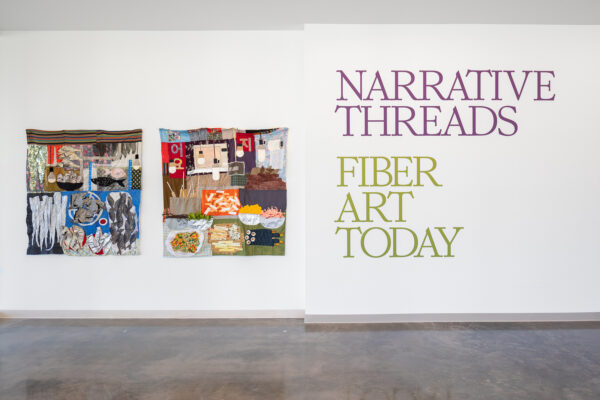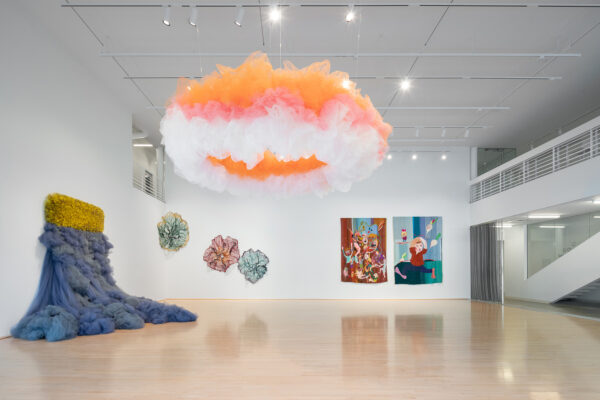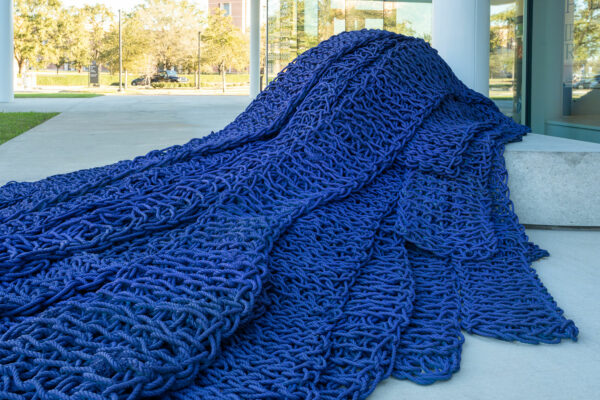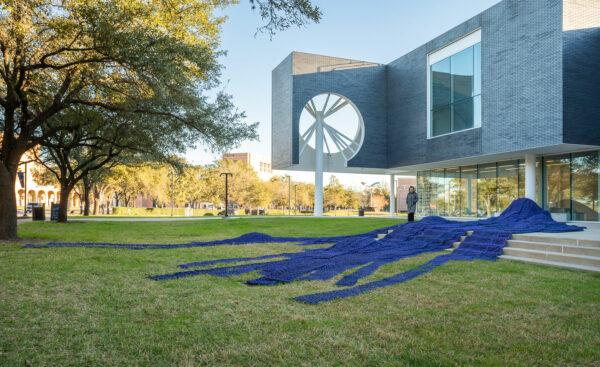
Installation view, “Narrative Threads: Fiber Art Today,” 2023, on view at the Moody Center for the Arts at Rice University in Houston. Photo: Sean Fleming Photography.
How can traditional arts speak to our present moment? Narrative Threads: Fiber Art Today, on view at the Moody Center for the Arts in Houston, has answers. The exhibition features 22 artists with vastly different approaches to textile and fiber art. Ranging from sculptural to architectural forms, this group of national and local artists use fiber arts to address political imperatives and personal truths.
Reinvigorating this overlooked art form, Narrative Threads artists reengage the tactile to speak to contemporary social issues ranging from gendered labor to cultural identity and racial inequity. The exhibition is kicked off with artist Ana María Herardo’s Cloud (2018), a halo of sheer orange and white tulle suspended from the ceiling. Now based in Denver, Herardo originally hails from Argentina, where she came from a lineage of textile-makers. Cloud marks an ode to the environmental. “It brings the sky to us,” Herardo explained in a January 12, 2023 walkthrough of the exhibition, “and us to the sky.”

Installation view, “Narrative Threads: Fiber Art Today,” 2023, on view at the Moody Center for the Arts at Rice University in Houston. Photo: Sean Fleming Photography.
Other artists, like Sagarika Sundaram, connect fiber art to the body and to community. The veins of mauve and electric green wool shot through Sagarika Sundaram’s Flame of the Forest (2022), created by wetting and then rolling the wool, are reminiscent of human internal systems as well as the natural world. Sundaram told visitors during her January artist talk that growing up in India, she was exposed to classical Indian art that represented nature as something to be feared and respected, reflecting floral and bodily forms. The overlays of pressed cream, ruby, and moss fabric create a feeling that is both neurological and psychological.
Sundaram’s Passage Along the Edge of the Earth (2022), a curtain of white and speckled blue wool, was inspired by the artist’s study of nomadic architecture and her work with indigenous Himalayan artisans. This wool “house” both hides and reveals viewers as they pass through its “walls.”
Here, one thinks of the deeply psychological nature of textile works by Louise Bourgeois, like We Love You (2001) and Untitled (2001) for the ways in which the soft, emotion-laden materials in these works in particular speak to the emotional landscape and gendered positionality of the artist. Bourgeois used textiles as a mode of psychological exploration and extraction, mining her subjectivity with a medium historically seen as “womens’ work.”

Installation view, “Narrative Threads: Fiber Art Today,” 2023, on view at the Moody Center for the Arts at Rice University in Houston. Photo: Sean Fleming Photography.
Diedrick Brackens’s the pondkeepers (2020) plays with figure and silhouette and history and representation in a sense reminiscent of Kara Walker’s reappropriation of Victorian shadow portraits. A monumental, fraying tapestry of aquamarine, black, and persimmon cotton and yarn, the piece features two figures holding a catfish while a third stretches beneath. It feels at once folkloric, mythological, and deeply contemporary. The piece draws inspiration from a lake near Bracken’s hometown of Mexia, Texas, a location mired by as much beauty as racial strife. According to Artsy, Brackens’ work is more broadly influenced by West African weaving, European tapestry, and quilting from the American South, thus addressing unacknowledged Black creative production, labor, and injustice. “I think of the process of handweaving cotton as a small way to pay tribute to those who came before me,” Brackens told Cultured in 2018, “and worked with the material under very different circumstances.” Brackens’ work reframes textiles as a mode of intergenerational communication and cultural critique.
Woomin Kim’s Shijang: Fish Market II (2021) speaks to the joys of routine life — meals, markets, sustenance, small consumer goods — and everyday abundance. Yet this depiction of daily, localized life also implies movement. As critic John Yau writes in Hyperallergic, “…Kim shows the nomadic side of global capitalism, that of the small shopkeeper who runs an outdoor stall temporarily set up in a designated part of a city.”

Installation view, “Narrative Threads: Fiber Art Today,” 2023, on view at the Moody Center for the Arts at Rice University in Houston. Photo: Sean Fleming Photography.
Sarah Zapata’s work takes us away from the figurative and pulls us towards the abstract. According to her website, the Corpus Christi-born artist is inspired by Peruvian heritage and feminist theory, the themes of her work ranging among topics such as labor, power, queerness, and cultural relativism. As she puts it, her art practice “exists in the liminal spaces between the past and the present, between craft and fine art, between South and North America. Like Janus, these works act as doorways — looking at the past and future at the same time, existing as testaments to intersectionality.” One can feel this in the eye-popping color of fabrics pulled together by coiling and weaving, uncanny objects that feel at both familiar and unknowable.
The works in Narrative Threads: Fiber Art Today are visually separate and intertwining through a porous design scheme created by the architecture and graphic design studio, world. At once open and intimate, the space is split by long colored bands hanging from the wall, which serve as a malleable barrier between the works. Alejandro Stein, one of world’s founding partners, maintains that the exhibition’s shape is reminiscent of weaving. “Thread is the smallest unit of composition,” Stein elaborated, during a January 2023 walk through of the show. “There’s a visual softness but a softness as if you can penetrate a wall, a barrier.”

Installation view, “Narrative Threads: Fiber Art Today,” 2023, on view at the Moody Center for the Arts at Rice University in Houston. Photo: Sean Fleming Photography.
Narrative Threads is most definitely an exhibition interested in penetrating barriers, be they metaphorical or literal. It shows viewers how fiber art can be molded to fit the concerns and sensibilities of today, while binding us to the social histories that came before us.
Narrative Threads is on view at the Moody Center for the Arts through May 13, 2023.


